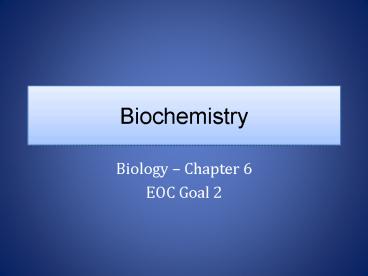Biochemistry PowerPoint PPT Presentation
1 / 30
Title: Biochemistry
1
Biochemistry
- Biology Chapter 6
- EOC Goal 2
2
Basic Chemistry
3
Basic Chemistry
- Atoms are the basic unit of matter.
- Made of
- Protons
- Neutrons
- Electrons
4
Basic Chemistry
- Elements are pure substances that are made of one
type of atom. - Chemical symbols are used to represent each atom.
- Found on the Periodic Table
5
Basic Chemistry
- Compounds are combinations of 2 or more atoms.
- Combination has different properties than the
individual atoms - Chemical formula shows the number and type of
atoms in a compound
6
Basic Chemistry
- Compounds are held together with chemical bonds.
- Types of Bonds
- Ionic Bonds
- Exchange electrons
- Called ions
- Covalent Bonds
- Share electrons
- Called molecules
7
pH Scale
- Acids, Bases, and pH
- Acids ? make hydrogen ion in water are bitter to
the taste - Examples lemon juice, vinegar, stomach acid
- Bases ? make hydroxide ion in water are slippery
to the touch - Examples soaps, Clorox, Pepto Bismol
- pH Scale ? scale that measures acid and base
- Range 0 Acid 7 Base 14
A buffer is used to maintain a certain pH level.
8
Biochemistry
9
Biochemistry
- Study of the chemicals necessary for living
things. - Also called organic chemistry.
- Involves the element carbon (C) in a covalent bond
10
Biochemistry
- Six elements needed in large quantities for
living things are - Carbon, hydrogen, nitrogen, oxygen, phosphorus,
and sulfur - Elements needed in small quantities are called
trace elements.
11
Biochemistry
- Terms to Know
- Monomer the smallest unit of a substance
- Example like one Lego block
- Polymer many monomers linked together to make a
large structure also called macromolecules - Example Lego blocks put together to make a
Lego house
12
Bio-Molecules
- Types of Organic Molecules
- (Bio-molecules)
- Carbohydrates
- Lipids
- Proteins
- Nucleic Acids
13
Carbohydrates
14
Carbohydrates
- Also called sugars and starches
- Composed of carbon, hydrogen, and oxygen in a
121 ratio (Example C6H12O6) - Typically end in ose (Example glucose)
- Function to store and release quick energy (but
if not used, these are stored as fat) - Test Used To Identify StarchgtIodine
15
Carbohydrates
- One unit of sugar (monomer )? monosaccharide
- Example glucose, fructose
- Two units of sugar ?
Disaccharide - Example sucrose, lactose
- Many units of sugars (polymer) ? Polysaccharide
16
(No Transcript)
17
Carbohydrates
- Examples of Polysaccharides
- Starch ? sugars in plants
- Glycogen ? energy storage in animal muscle (makes
muscle meat dark) - Cellulose ? found in plant cell walls animals
can not digest (roughage) - Chitin ? in insect exoskeletons
18
Lipids
19
Lipids
- Commonly called fats, oils, and waxes
- Composed of carbon, hydrogen, and oxygen in a
non-specific ratio (Example C21H17O43) - Function
- Quick energy (twice as much as carbs)
- Insulation, body padding
- Test Used to Identify Brown Paper Bag
20
Lipids
- Monomer ? glycerol and 3 fatty acids
21
Lipids
- Types of Lipids (Fats)
- Saturated bonds in molecule are unbendable
tend to clog arteries typically from animals
(fats, butter, lard) - Unsaturated some bonds in molecule bend
better, but can still clog arteries typically
from plants (oils) - Polyunsaturated many bonds in molecule bend
best type of fat to eat typically from plants
(oils)
22
(No Transcript)
23
Proteins
24
Proteins
- Composed of carbon, hydrogen, oxygen, nitrogen,
and sometimes sulfur - Monomer ? amino acids
- Polymer ? polypeptide
- Account for 50 of the dry weight of cells
- Test Used To Identify Biuret
25
(No Transcript)
26
Proteins
- Functions of Proteins
- Structure (cells,tissues)
- Fibers in bone, tendons, ligaments, and cartilage
- Homeostasis regulation (hormones and enzymes)
- Metabolism
- Defense against disease (antibodies)
27
Enzymes (Catalysts)
- Enzymes are special proteins that act as
catalysts in the body. - Catalysts Substances that
- speed up chemical reactions
- without being affected by
- the reaction themselves.
28
Nucleic Acids
29
Nucleic Acids
- Made of carbon, hydrogen, oxygen, nitrogen, and
sulfur - Function ? control genetic information
- Monomer ? nucleotide
- Polymers
- DNA ? deoxyribonucleic acid
- RNA ? ribonucleic acid
30
(No Transcript)

